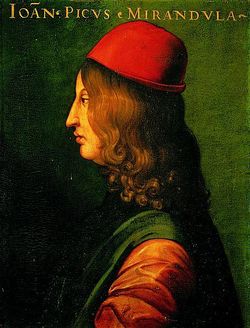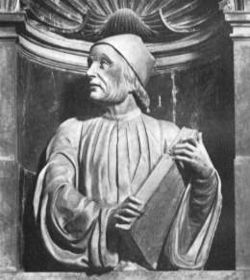Difference between revisions of "Category:Enochic Studies--1450s"
| Line 1: | Line 1: | ||
[[File:Giovanni Pico della Mirandola.jpg|thumb|250px|Giovanni Pico della Mirandola]] | |||
[[File:Hermes Trismegistus.jpg|thumb|250px|Hermes Trismegistus (Cathedral of Siena)]] | |||
[[File:Marsilio Ficino.jpg|thumb|250px|Marsilio Ficino]] | |||
[[File:Cosimo de Medici.jpg|thumb|250px|Cosimo de Medici]] | |||
* [[:Category:Enochic Studies|BACK to the ENOCHIC STUDIES--INDEX]] | * [[:Category:Enochic Studies|BACK to the ENOCHIC STUDIES--INDEX]] | ||
Revision as of 08:08, 5 April 2014
Enochic Studies in the 1400s--Works and Authors
< ... -- 1400s -- 1500s -- 1600s -- 1700s -- 1800s -- 1850s -- 1900s -- 1910s -- 1920s -- 1930s -- 1940s -- 1950s -- 1960s -- 1970s -- 1980s -- 1990s -- 2000s -- 2010s -- ... >
Overview
The interest in Enochic Studies first developed in 15th-century Italy in esoteric circles during the Renaissance. In 1460 Cosimo de' Medici acquired the mss of the Corpus Hermeticum and in 1463 Marsilio Ficino completed its first translation. The Corpus Hermeticum, collected in the 11th century by Michael Psellos, was seen as a compendium of the most ancient human wisdom and was attributed to Hermes Trismegistus, who in turn was associated or identified with Enoch.
The "Christian Cabalists" were the first ones who actively tried to recover the wisdom of Enoch and his "lost" book(s). Giovanni Pico della Mirandola claimed that he had it as he possessed the "seventy secret books of Ezra." What Pico had was actually a copy of Menahem Recanati's cabalistic commentary. Pico commissioned a Latin translation of Recanati's work, that was completed in 1486 by Guglielmo Raimondo Moncada (Flavius Mithridates).
While the Christian Cabalists were more scholarly-oriented toward the continuous search for manuscript evidence, other intellectuals were more engaged in magical and visionary experiences. In the 1480s, humanist Ludovico Lazzarelli, also a translator of the Corpus Hermeticum, endorsed Giovanni "Mercurio" da Correggio as a prophet and messiah. Like Lazzarelli, other humanists of the time, such as Carlo Sosenna and the Jewish scholar Abraham Farissol, report that Giovanni da Correggio claimed to be the "Young Hermes," the son of Hermes Trismegistus, Methuselah and Enoch. On Palm Sunday, 11 April 1484 Correggio entered the city of Rome, riding on a white donkey in imitation of Jesus, surrounded by his family and disciples, claiming to be "the angel of wisdom," "Poimandres" (or Pimander, a Hermetic manifestation of the mind of God), and "the most perfect manifestation of Jesus Christ." ("Ego Joannes Mercurius de Corigio, sapientiae angelus Pimanderque in summo ac maximo spiritus Jesu Chrisi excessu, hanc aquam regni pro paucis, sic super omnes magna voce evangelizo"). Acting as a sort of Enoch redivivus, Lazzarelli published in 1490 an Epistula Enoch in support of Giovanni da Correggio.
@2014 Gabriele Boccaccini, University of Michigan
Pages in category "Enochic Studies--1450s"
The following 6 pages are in this category, out of 6 total.
1
- Oratio de hominis dignitate (Oration on the Dignity of Man / 1486 Pico della Mirandola), book (Latin)
- Commentarius in legem Mosis (1486 Moncada) = פירוש על התורה (Commentary on the Torah / early 14th cent. Recanati), ms. (Latin ed.) (lost)
- Epistula Enoch (1490 Lazzarelli), vision (Latin)
- De verbo mirifico (On the Wonder-Working Word / 1494 Reuchlin), book (Latin)



